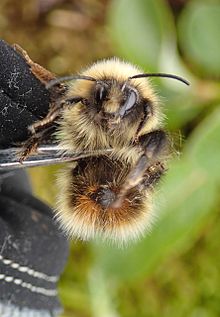Bombus balteatus
| Bombus balteatus | |
|---|---|

| |
| Scientific classification | |
| Domain: | Eukaryota |
| Kingdom: | Animalia |
| Phylum: | Arthropoda |
| Class: | Insecta |
| Order: | Hymenoptera |
| Family: | Apidae |
| Genus: | Bombus |
| Subgenus: | Alpinobombus |
| Species: | B. balteatus
|
| Binomial name | |
| Bombus balteatus | |
Bombus balteatus, the golden-belted bumble bee, is a species of bumblebee with a boreal and high altitude distribution in northern Eurasia and North America.
Range and distribution[edit]
This species is found in Finland, northern Sweden, Russia,[3] and North America from arctic Alaska, Canada, and mountain ranges in the United States such as the Sierra Nevada and the White Mountains down south to New Mexico.[4] Their preferred habitat includes high altitude and boreal regions, and they are often found at higher elevations than the tree line.[1] Bombus balteatus is often most abundant where Castilleja, Chrysothammnus, and Mertensia plant species are common.[5] Some populations of bees, including in the Rocky Mountains, specifically Mount Blue Sky, Niwot Ridge and Pennsylvania Mountain have declined in the 21st century.
Morphology[edit]
Bombus balteatus is a long-tongued bumblebee. Often the tongue length reaches two-thirds or more the length of the body.[5] This morphological feature allows them to specialize on flowers with long corollas.[6] In North America, workers can be identified by a distinctive black abdomen pattern and robust body.[5]
Systematics[edit]
The most closely related species are Bombus hyperboreus, Bombus frigidus, and Bombus mixtus, which all occur in Western North America and Arctic Europe.[5]
Effects of climate change[edit]
In the Rocky Mountains, USA, many native plants species include flowers with elongated corollas. With abundant resources, B. balteatus can be a dominant species in the ecosystem.[7] However, Rocky Mountain bumblebees, including B. balteatus and Bombus sylvicola, have shown changes in abundance and foraging range as long-tubed floral resources are declining at higher altitudes; they have also exhibited a trend towards shorter tongues over the last 40 years.[6] This is indicative of niche expansion; although this species of bumblebee is considered highly specialized, it is now adapting to forage on a broader range of morphologically diverse flowering plants.[6] Immigration by short-tongued bumble bees into higher altitudes, as well as an increase in the number of Bombus balteatus individuals with shorter tongues, has also occurred as a result of warming and climate change. This creates new competition for long-tongued B. balteatus for limited floral resources.[6]
References[edit]
- ^ a b Hatfield, Richard. "IUCN Assessments for North American Bombus spp. for the North American IUCN Bumble Bee Specialist Group". ResearchGate. Retrieved 2017-04-25.
- ^ ITIS Report
- ^ "Map of Bombus balteatus". Discover Life. Retrieved 4 November 2012.
- ^ "North American bumblebees". Bumblebee.org. Retrieved 4 November 2012.
- ^ a b c d Williams, Paul (2014). Bumble Bees of North America. New Jersey: Princeton University Press. pp. 103–105. ISBN 978-0691152226.
- ^ a b c d Miller-Struttmann, Nicole E.; Geib, Jennifer C.; Franklin, James D.; Kevan, Peter G.; Holdo, Ricardo M.; Ebert-May, Diane; Lynn, Austin M.; Kettenbach, Jessica A.; Hedrick, Elizabeth (2015-09-25). "Functional mismatch in a bumble bee pollination mutualism under climate change". Science. 349 (6255): 1541–1544. Bibcode:2015Sci...349.1541M. doi:10.1126/science.aab0868. ISSN 0036-8075. PMID 26404836.
- ^ Geib, Jennifer C.; Strange, James P.; Galenj, Candace (2015-04-01). "Bumble bee nest abundance, foraging distance, and host-plant reproduction: implications for management and conservation" (PDF). Ecological Applications. 25 (3): 768–778. doi:10.1890/14-0151.1. ISSN 1051-0761. PMID 26214921.

